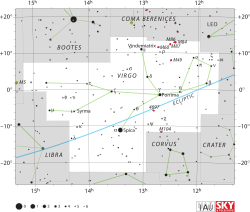Tau Virginis
Tau Virginis ( τ Virginis, förkortat Tau Vir, τ Vir) som är stjärnans Bayerbeteckning, är en ensam stjärna[13] belägen i nordöstra delen av stjärnbilden Jungfrun. Den har en skenbar magnitud på +4,28[2] och är svagt synlig för blotta ögat. Baserat på parallaxmätning inom Hipparcosuppdraget på 14,5 mas,[1] beräknas den befinna sig på ett avstånd av ca 225 ljusår (69 parsek) från solen.
| (Tau Virginis (τ) | |
 | |
| Observationsdata Epok: J2000.0 | |
|---|---|
| Stjärnbild | Jungfrun |
| Rektascension | 14t 01m 38,79341s[1] |
| Deklination | 01° 32′ 40,3145″[1] |
| Skenbar magnitud () | 4,2777 ± 0,0007[2] |
| Stjärntyp | |
| Spektraltyp | A2IV/V[3] |
| U–B | +0,12[4] |
| B–V | +0,11[4] |
| Astrometri | |
| Radialhastighet () | -6,7 ± 0,9[5] km/s |
| Egenrörelse (µ) | RA: +17,49[1] mas/år Dek.: -21,27[1] mas/år |
| Parallax () | 14,50 ± 0,18[1] |
| Avstånd | 225 ± 3 lå (69,0 ± 0,9 pc) |
| Absolut magnitud () | +0,5[6] |
| Detaljer | |
| Massa | 1,96[7] M☉ |
| Radie | 1,6[8] R☉ |
| Luminositet | 70[9] L☉ |
| Temperatur | 8 413 ± 286[7] K |
| Metallicitet | -0,19[10] |
| Vinkelhastighet | 186[11] km/s |
| Ålder | 724[7] miljoner år |
| Andra beteckningar | |
| Ti , 93 Virginis, BD + 02 ° 2761, FK5 516, HD 122408, HIP 68520, HR 5264, SAO 120238.[12] | |
Egenskaper
redigeraTau Virginis är en blå stjärna i huvudserien av spektralklass A2IV/V[3] med vissa spektraldrag av en underjätte. Den har en massa som är nästan dubbelt så stor som solens och en radie som är 1,6 gånger solens radie[8]. Den utsänder från sin yttre atmosfär 70 gånger mer energi än solen vid en effektiv temperatur på ca 8 400[7]K. Tau Virginis är ca 700[7] miljoner år gammal och roterar snabbt med en prognostiserad rotationshastighet på 186 km/s.[11]
Tau Virginis har flera visuella följeslagare, enligt tabellen nedan:[14]
| Följeslagare | Skenbar magnitud |
Separation bågsekunder |
Positions- vinkel |
Uppmätt år |
|---|---|---|---|---|
| B | 9,41 | 82,70″ | 287° | 2012 |
| C | 13,10 | 176,70″ | 353° | 2000 |
| D | 9,68 | 342,70″ | 85° | 2012 |
| E | 12,00 | 14,6″ | 175° | 2009 |
Källor
redigera- Den här artikeln är helt eller delvis baserad på material från engelskspråkiga Wikipedia, tidigare version.
Referenser
redigera- ^ [a b c d e f] van Leeuwen, F. (November 2007), "Validation of the new Hipparcos reduction", Astronomy and Astrophysics, 474 (2): 653–664, Bibcode:2007A&A...474..653V, arXiv:0708.1752 Freely accessible, doi:10.1051/0004-6361:20078357.
- ^ [a b] Adelman, S. J. (February 2001). "Research Note Hipparcos photometry: The least variable stars". Astronomy and Astrophysics. 367 (1): 297–298. Bibcode:2001A&A...367..297A. doi:10.1051/0004-6361:20000567.
- ^ [a b] Houk, N.; Swift, C. (1999), "Michigan catalogue of two-dimensional spectral types for the HD Stars, Vol. 5", Michigan Spectral Survey, 05, Bibcode:1999MSS...C05....0H
- ^ [a b] Mermilliod, J.-C. (1986), Compilation of Eggen's UBV data, transformed to UBV (unpublished), SIMBAD, Bibcode:1986EgUBV........0M
- ^ Gontcharov, G. A. (2006), "Pulkovo Compilation of Radial Velocities for 35 495 Hipparcos stars in a common system", Astronomy Letters, 32 (11): 759–771, Bibcode:2006AstL...32..759G, doi:10.1134/S1063773706110065.
- ^ [ Blondel, P. F. C.; Djie, H. R. E. Tjin A. (September 2006), "Modeling of PMS Ae/Fe stars using UV spectra", Astronomy and Astrophysics, 456 (3): 1045–1068, Bibcode:2006A&A...456.1045B, doi:10.1051/0004-6361:20040269.6]
- ^ [a b c d e] David, Trevor J.; Hillenbrand, Lynne A. (2015), "The Ages of Early-Type Stars: Strömgren Photometric Methods Calibrated, Validated, Tested, and Applied to Hosts and Prospective Hosts of Directly Imaged Exoplanets", The Astrophysical Journal, 804 (2): 146, Bibcode:2015ApJ...804..146D, arXiv:1501.03154 Freely accessible, doi:10.1088/0004-637X/804/2/146.
- ^ [a b] Pasinetti Fracassini, L. E.; et al. (February 2001), "Catalogue of Apparent Diameters and Absolute Radii of Stars (CADARS) - Third edition - Comments and statistics", Astronomy and Astrophysics, 367 (2): 521–524, Bibcode:2001A&A...367..521P, arXiv:astro-ph/0012289 Freely accessible, doi:10.1051/0004-6361:20000451.
- ^ McDonald, I.; et al. (2012), "Fundamental Parameters and Infrared Excesses of Hipparcos Stars", Monthly Notices of the Royal Astronomical Society, 427 (1): 343–57, Bibcode:2012MNRAS.427..343M, arXiv:1208.2037 Freely accessible, doi:10.1111/j.1365-2966.2012.21873.x.
- ^ Morossi, C.; et al. (September 2002), "Metallicity Determinations from Ultraviolet-Visual Spectrophotometry. I. The Test Sample", The Astrophysical Journal, 577 (1): 377–388, Bibcode:2002ApJ...577..377M, doi:10.1086/342144.
- ^ [a b] Royer, F.; et al. (February 2007), "Rotational velocities of A-type stars. III. Velocity distributions", Astronomy and Astrophysics, 463 (2): 671–682, Bibcode:2007A&A...463..671R, arXiv:astro-ph/0610785 Freely accessible, doi:10.1051/0004-6361:20065224.
- ^ "* tau Vir". SIMBAD. Centre de données astronomiques de Strasbourg. Hämtad 2016-09-16.
- ^ Eggleton, P. P.; Tokovinin, A. A. (September 2008), "A catalogue of multiplicity among bright stellar systems", Monthly Notices of the Royal Astronomical Society, 389 (2): 869–879, Bibcode:2008MNRAS.389..869E, arXiv:0806.2878 Freely accessible, doi:10.1111/j.1365-2966.2008.13596.x.
- ^ Mason, B. D.; et al. (2014), "The Washington Visual Double Star Catalog", The Astronomical Journal, 122: 3466–3471, Bibcode:2001AJ....122.3466M, doi:10.1086/323920, hämtad 2015-07-22.



